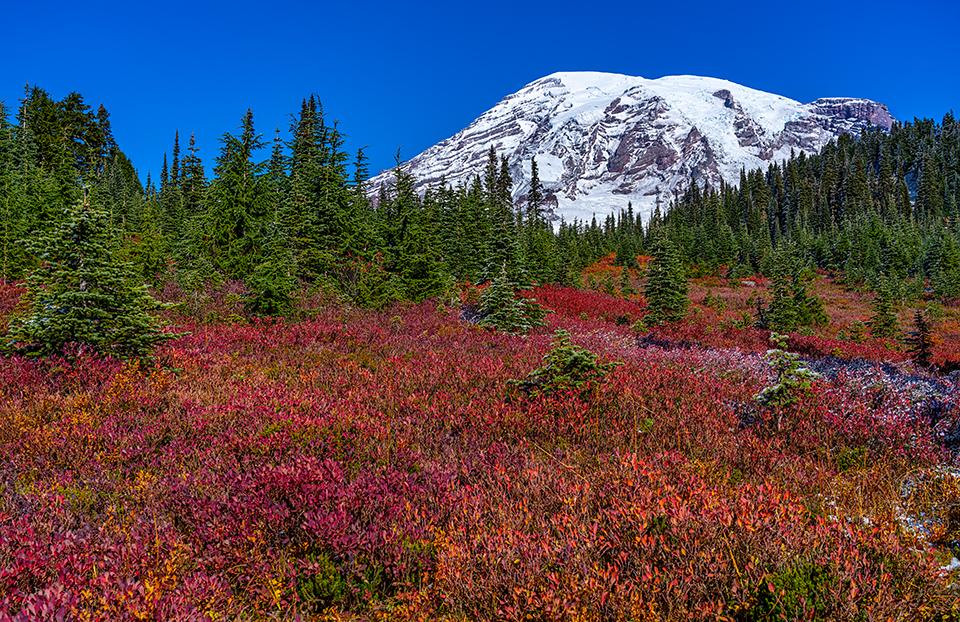
Paradise in the fall, Mount Rainier National Park / Rebecca Latson
Winter is just around the corner, but there’s still a little bit of fall left. So, this month’s column is all about capturing fall color and character. It’s my favorite season and brings to mind landscapes filled with aspen trees and huckleberry bushes painted brilliant hues of orange, gold, yellow, and red. I think of such national parks as Acadia, Shenandoah, Great Smoky Mountains, Glacier, Yosemite, Great Basin, Rocky Mountain and Mount Rainier. Of course, these are not the only park units whose vegetation changes colors with the season, but they are certainly among the most well-known and -visited during the fall. Although autumn does not necessarily color all parks equally (hello Arches and Canyonlands and Everglades national parks), for this month’s column, I want to focus on photographing fall color and my examples are from a national park that does possess that distinct season: Mount Rainier National Park.
Why Mount Rainier? Well, I’m very fortunate this national park in Washington state is only about one-and-a-half to two hours’ drive away from my home. During the winter, it’s maybe three hours, due to weather and the fact I must access a different route to this park. You could say Mount Rainier is my “go to” park, which is why I include photos captured there in many of the articles I pen for the Traveler.
Before I continue, I want you to bear in mind that while the photos you see here were shot at Mount Rainier, the photographic concepts about which I write may be applied to any park with autumn color. These images are simply examples of those concepts.
If there’s a park unit you’ve visited before and are planning a repeat trip, then consider yourself a photographic step ahead of the rest with a pretty good idea of where to get great sunrise and sunset shots of that autumn landscape. You might want to think about including blue hour imagery with those fall sunrises and sunsets. Blue hour refers to that time just prior to sunrise and just after sunset, when the sky and landscape are swathed in a veil of blue, purple, pink and mauve. Granted, autumn colors may not show up in a nighttime or blue hour photo. Then again, they just might, under the right conditions.
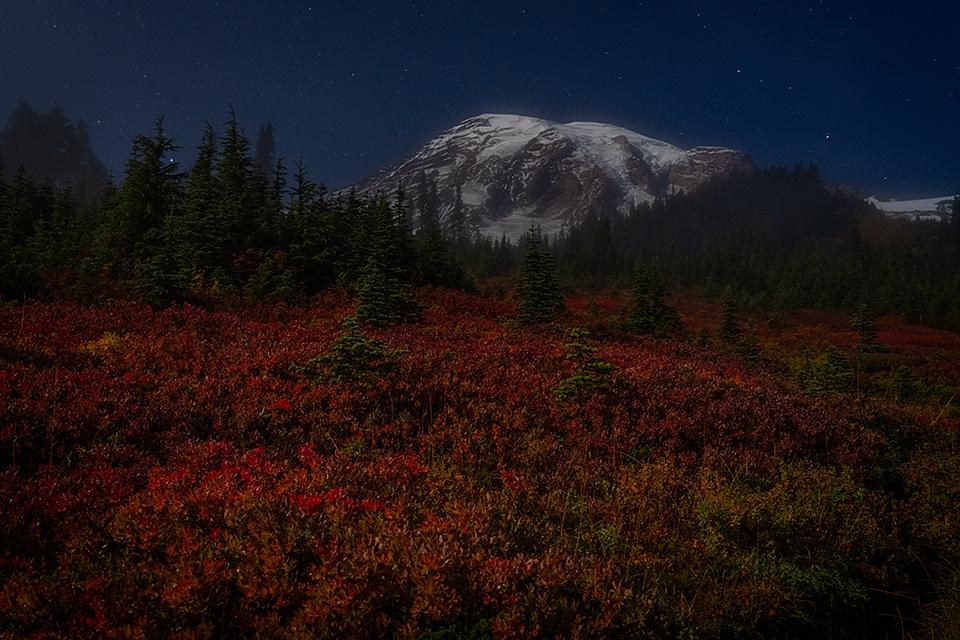
Moonlight and mist over "The Mountain," Mount Rainier National Park / Rebecca Latson
The photo above is a good example of how you might be able to capture fall colors before the sun even rises. The full October moon was not only bright enough to hide the stars and bring out my shadow, but also bright enough to illuminate the morning mist and those huckleberry bushes. Ok, full disclosure, even with the bright moonlight, I still needed to bump up the ISO to 2500, open the aperture to f/5.0 and slow the shutter speed to 30 seconds, to get the camera to see what I saw with my own eyes.
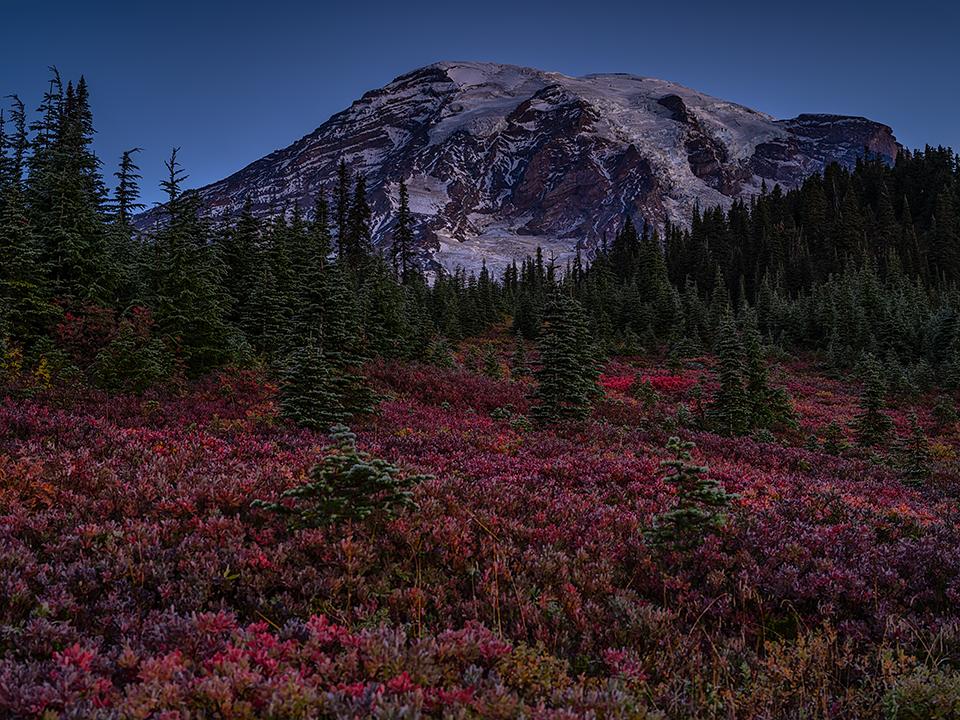
Blue hour at Paradise, Mount Rainier National Park / Rebecca Latson

An autumn sunrise at Paradise, Mount Rainier National Park / Rebecca Latson
I remained in this spot to capture blue hour and sunrise views, too. As you look at these images, notice how the time of day changes the atmospheric light, thus producing different color casts to the landscape. And here’s an interesting little tidbit you may have already noticed on your own regarding the sequence of a sunrise. As the sun begins its ascent above the horizon to shine on a snowcapped mountain, what you’ll usually see first is plain white light illuminating the mountain. As the sun continues to rise, then the color kicks in, but only for a few moments. So, even if you don’t plan to photograph a blue hour scene, you should still arrive early enough at your spot to set up and prepare for that sunrise light sequence.
Hey, FYI, if you happen to be at Mount Rainier during September and October and want to capture similar shots with your own camera to what you see here (remember my article about it being ok to photograph an oft-photographed spot?), all you need to do is climb up those etched steps near the Henry M. Jackson Memorial Visitor Center. Position your tripod to the left side of the paved trail beside the small chained area and aim or zoom your camera lens such that it frames “The Mountain” in the background and the colorful vegetation in the foreground without including any trail or people.
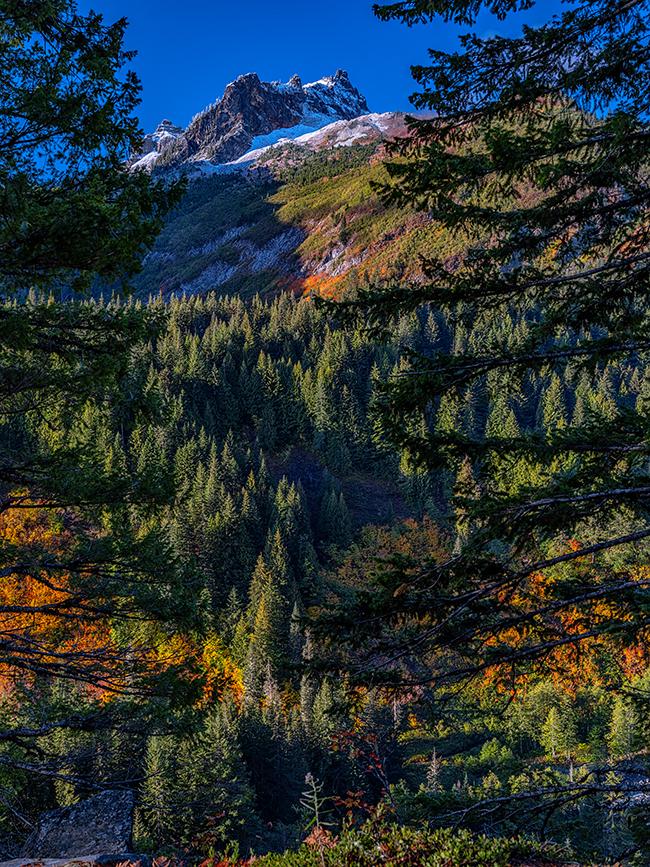
Fall landscape along Stevens Canyon Road, Mount Rainier National Park / Rebecca Latson
Use autumn colors as frames for your composition, or to highlight the subject within your composition. This shot, for instance, captured at one of the small pullouts paralleling Stevens Canyon on the way up to Paradise, uses tree branches as natural frames on either side of the thickly-forested canyon wall dotted with bright orange and red fall color contrasting with the evergreens.

A little fall color along the trail, Mount Rainier National Park / Rebecca Latson
When it comes to photographing brightly-colored leaves, you don’t necessarily need a mountain or tree landscape for a background. Just fill your frame with color. To emphasize your subject even more, play around with the addition of a little vignetting, which is shading the edges of the composition to further accentuate the subject. Various photo editing software plug-ins, as well as smartphone apps and Instagram have vignetting options.

Layers of fall color, Mount Rainier National Park / Rebecca Latson
Look for layers in the fall landscape.

Still hanging on, Mount Rainier National Park / Rebecca Latson
Photograph other examples of autumn, too, such as skeletal bushes with nothing but a few remaining bright berries hanging on for dear life.
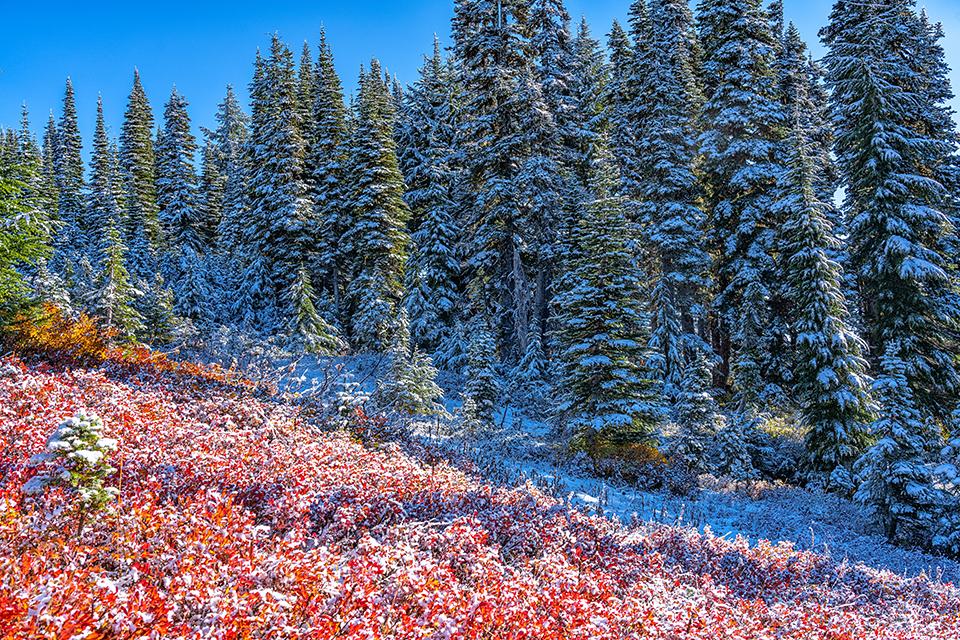
A diagonal dividing line snowy color, Mount Rainier National Park / Rebecca Latson
If Sir or Madam would like a little winter snow accompanying their autumn color, then think about traveling to a national park unit with a bit of elevation to it. That magic dusting of bright, white snow makes an interesting juxtaposition to those autumn colors. Ok, so your park visit might not be timed for an early snowfall, but serendipity does happen, on occasion.

Autumn color and snow along the trail, Mount Rainier National Park / Rebecca Latson
A snowy trail – even one with boot prints – makes an eye-catching leading line among the fall scenery.
While fall colors of 2021 may be starting to dull with the onset of colder days, you can still start planning for your 2022 autumn trip (and nowadays, it pays to plan way ahead). Check out past articles on the Traveler for places to photograph that color. Go into Flickr.com and search on fall color (did you know, the Traveler has a Flickr site?). Take a look at those park Instagram sites for autumn examples of colorful locations – this includes the Traveler’s Instagram site @national_parks_traveler. With a little bit of planning and preparation, when the time arrives, you can take your camera and go enjoy those cool fall days while adding a little color to your compositions.
Note: cold, crisp autumn days can create icy trails, roads, and sidewalks, especially after a bit of snowfall. It never hurts to bring along a pair of ice traction devices to slip over your boots. Yaktrax and Kahtoola are popular, but there are many other brands you can pull up via an internet search. I keep a spare pair of boots with Yaktrax slip-ons in my vehicle for such occasions.



Comments
Beautifully written and documented article. Thank you from San Jose, Calif.
Even sitting here at home, reading your instructions along with the pertinent photograph is fairly immersive. Well done.